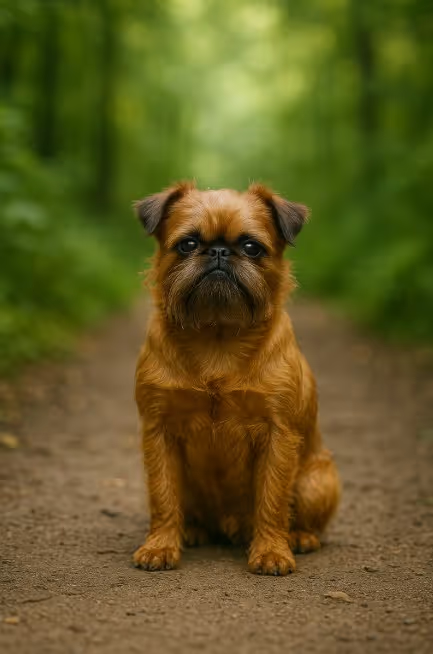The Brussels Griffon is a big personality in a tiny, bearded package. Lively, sensitive, and people-obsessed, “Griffs” shadow their humans like Velcro and thrive on training games and couch cuddles. Available in rough (wiry) and smooth coat varieties, they’re great apartment dogs with modest exercise needs. If you’re searching “Are Brussels Griffons hypoallergenic?”—no, but rough, hand-stripped coats shed very little. “Do Brussels Griffons bark a lot?”—they can be alert; teach “quiet.”

Originating in Brussels, Belgium, the breed developed from stable ratters (Affenpinscher/Smousje types) crossed with toy spaniels and Pugs, creating the expressive face and compact companion we know today. The breed diverged into rough-coated and smooth-coated varieties and gained popularity in the late 19th century among city dwellers and European nobility. Modern Griffs are cherished worldwide as spirited, loyal companions and fun sport dogs (obedience, rally, agility).
A toy companion with a human-like expression and compact, square build.
Low coat volume, but face and (for rough) hand-stripping matter.
A playful toy with moderate stamina.
Bright, sensitive, and people-focused—keep it upbeat and brief.
Small dog, big appetite—measure portions and protect dental health.
Generally long-lived; some toy/short-muzzle issues to watch.
Seek transparency on health, temperament, and grooming—or consider rescue.
Are Brussels Griffons good apartment dogs?
Yes—compact, people-oriented, and satisfied with 30–45 minutes of daily activity.
Are Brussels Griffons hypoallergenic?
No. Rough coats shed very little when hand-stripped, but the breed isn’t truly hypoallergenic.
Do Brussels Griffons bark a lot?
They can be alert barkers. Teach a reliable “quiet” and provide enrichment.
Rough vs Smooth—what’s the difference in grooming and shedding?
Rough: hand-strip every 8–12 weeks; lowest shed. Smooth: easier routine, more visible shed seasonally.
How much exercise does a Griffon need?
About 30–45 minutes daily plus brain work (tricks, scent games).
Are Brussels Griffons good with kids and other pets?
Yes with gentle handling and early socialization; supervise due to small size and protect prominent eyes.
Do Brussels Griffons have breathing issues?
Some can be heat/airway sensitive (short muzzle). Keep them lean, use a harness, and avoid heat/hard exertion.
How hard is house training?
They’re smart but sensitive; stick to a schedule, reward outdoors immediately, and manage with a crate/pen between trips.